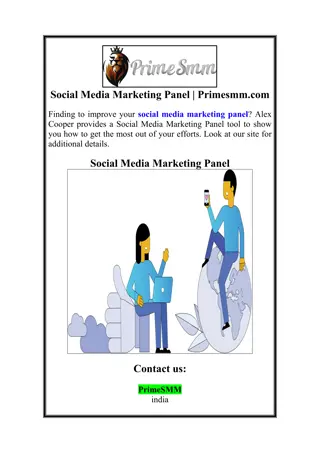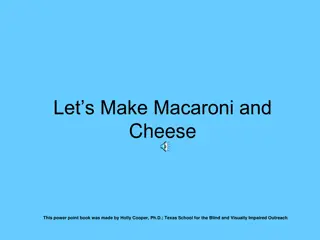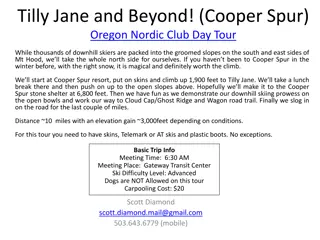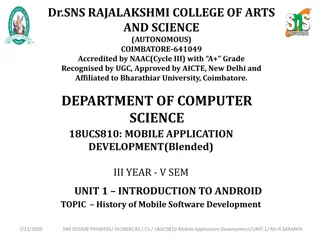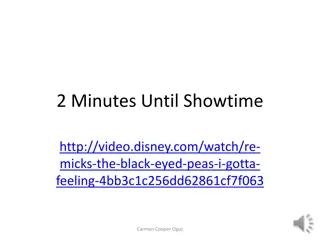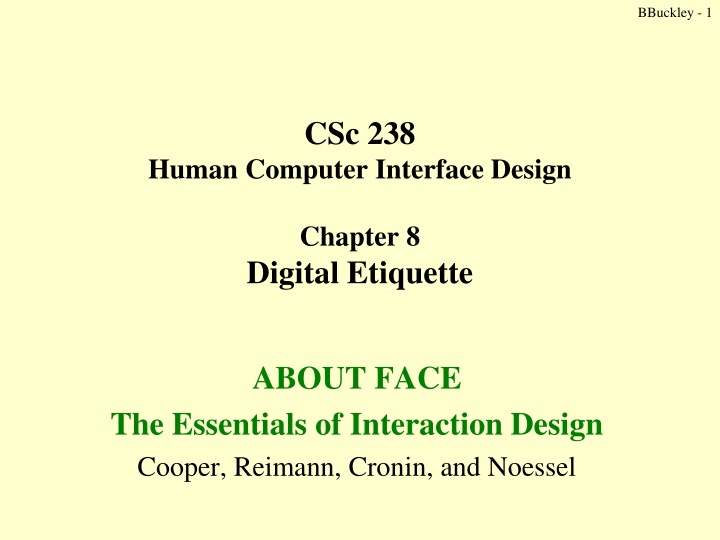
Interactive Design Principles for Considerate Software Users
Explore the essentials of human-computer interaction design focusing on digital etiquette and the importance of software behaving like a helpful human colleague. Learn how considerate interactive products can enhance user experience by being forthcoming, perceptive, and anticipatory of user needs.
Download Presentation

Please find below an Image/Link to download the presentation.
The content on the website is provided AS IS for your information and personal use only. It may not be sold, licensed, or shared on other websites without obtaining consent from the author. If you encounter any issues during the download, it is possible that the publisher has removed the file from their server.
You are allowed to download the files provided on this website for personal or commercial use, subject to the condition that they are used lawfully. All files are the property of their respective owners.
The content on the website is provided AS IS for your information and personal use only. It may not be sold, licensed, or shared on other websites without obtaining consent from the author.
E N D
Presentation Transcript
BBuckley - 1 CSc 238 Human Computer Interface Design Chapter 8 Digital Etiquette ABOUT FACE The Essentials of Interaction Design Cooper, Reimann, Cronin, and Noessel
2 Digital Etiquette If we want users to like our products, we should design them to behave in the same manner as a likeable person If we want users to be productive with our software, we should design it to behave like a supportive human colleague DESIGN PRINCIPLE The computer does the work, and the person does the thinking
3 Digital Etiquette If an interactive product is stingy with information, obscures its processes, forces users to hunt around for common functions, and is quick to blame people for its own failings, users are sure to have an unpleasant and unproductive experience. This will happen regardless of how polite, cute visually metaphoric, anthropomorphic, or full of interesting content the software is. DESIGN PRINCIPLE Software should behave like a considerate human being
4 The most important characteristics of considerate interactive products (and humans): Considerate products: Take an interest Are deferential Are forthcoming Use common sense Use discretion Anticipate people s needs Are conscientious Don t burden you with their personal problems Keep you informed Are perceptive Are self-confident Don t ask a lot of questions Fail gracefully Know when to bend the rules Take responsibility Help you avoid awkward mistakes
5 Considerate products take an interest Software should work hard to remember our habits and everything we tell them Web purchases Every time the information is needed the website should not require the user to re-enter it Order and then re-ordering by phone most companies have all the information they need after the first order. You call and they know your name, address, etc.
6 Considerate products are forthcoming Software should provide the user with related information that is related to their goals A helpful human would Example User prints a document What is not communicated: Paper supply is low There are other documents in the queue There s another printer that is available
7 Considerate products use common sense Many interactive products put controls for constantly used functions right next to never used controls. You can easily find menus offering simple, harmless functions adjacent to irreversible ejector-seat expert functions. Considerate products are conscientious Developer/designers need to be professionally OCD about quality and being considerate Obsessive Compulsive Disorder (OCD) is a mental disorder where people feel the need to check things repeatedly, perform certain routines repeatedly
9 Considerate products don t burden you with their personal problems We don t need to see information about the computer s data transfer rates and its loading sequence The software whines at us with error messages, interrupts us with confirmation dialog boxes, and unnecessary notifications ( Document Successfully Saved ) Considerate products keep you informed informed about things that matter to us (the user)
10 Considerate products are perceptive watching the user s preferences and remembering them without being asked explicitly to do so. Considerate products keep you informed informed about things that matter to the user Considerate products are perceptive Products should also watch our preferences and remember them without being asked explicitly to do so The cloud did it! Sharing the cloud Shut down Turn on - Open Word you get cloud s version with its fixed settings Document is set for Times New Roman to insert Text Box with its own default, Arial
11 Considerate products don t ask a lot of questions Users really don t like to be asked questions by products Asking questions tells users that the products are: Ignorant Forgetful Weak Fretful Lacking initiative Overly demanding ATM asks, each time! do you prefer Spanish, English or Chinese After the 1sttime they know you
12 Considerate products fail gracefully Example the application accepted e-mail from the server which then erased its copy but it didn t ensure the e- mail was properly recorded locally. Users often need to enter information into a set of forms on a page After filling in 10 or 11 fields, a user might click the Submit button, and, due to some mistake or omission have the site reject his input and tell him to correct it. The user then clicks the back arrow to find all the valid entries discarded. and then there is the need to click the back arrow!
13 Considerate products fail gracefully Example the application accepted e-mail from the server which then erased its copy but it didn t ensure the e- mailwas properly recorded locally. Users often need to enter information into a set of forms on a page After filling in 10 or 11 fields, a user might click the Submit button, and, due to some mistake or omission have the site reject his input and tell him to correct it. The user then clicks the back arrow to find all the valid entries discarded. and then there is the need to click the back arrow!
14 Considerate products help you avoid awkward mistakes Products that go the extra mile in looking out for users by helping them prevent embarrassing mistakes and not berating them for it will quickly earn their trust and devotion. Authors examples You are about to inadvertently send a text to your entire list of contacts instead of the one friend you were intending to confide in . Or to send an email to the director of your department without attaching the quarterly report mentioned in the text.
The most important characteristics of interactive products (and humans) 15 Smart products: Put idle cycles to work Have a memory Anticipate needs Remember details File locations Deducing information Multi-session Undo Past date entries Foreign application activities on application files
16 Smart products put idle cycles to work The argument against putting those cycles to work has always been We can t make assumptions; those assumptions might be wrong. We need a new, more proactive way of thinking about how software can help people reach their goals and complete their tasks
17 Smart products have memory The argument against putting those cycles to work has always been We can t make assumptions; those assumptions might be wrong. We need a new, more proactive way of thinking about how software can help people reach their goals and complete their tasks simply remember what the user did the last couple of times (and how), it can use that as a guide to how it should behave the next time.
18 Smart products anticipate needs our goals and how we achieve them (via tasks) is generally similar from day to day. Sally and I prefer a specific font and size We should not be required to reset the font and size each time we open Word, Excel, PowerPoint, etc. Most mainstream applications allow their users to set defaults, but this doesn t fit the bill as smart behavior !!!
19 Smart products remember details Any time your application finds itself with a choice, and especially when that choice is being offered to a user, the application should remember the information from run to run. If it's worth it to the user do do it, it's worth it to the application to remember it. DESIGN PRINCIPLE
20 If it's worth it to the user do do it, it's worth it to the application to remember it. DESIGN PRINCIPLE Decided not to lock the aspect ratio If it's worth it to the user do do it, it's worth it to the application to remember it. DESIGN PRINCIPLE
21 Designing Smart Products Making Smart Products work: Designers find that their thinking takes on a whole new quality. The normally unquestioned recourse of popping up a dialog box gets replaced with a more studied process in which the designer asks much more subtle questions. knowing the characteristic patterns in how people make choices
22 Decision-set reduction guides us to the idea that pieces of information the application must remember about the user s choices tend to come in groups. The application should look for more subtle clues to differentiate which one of the small set is correct. The user accepts the same date format 50 times in a row and then manually enters a different format once. The next time what should the application do? What was the characteristic pattern ?
23 Designing Social Products Social Products know the difference between social and market norms Social Norms Unspoken rules of reciprocity afforded to friends and family Things like lending a hand when in need and expressing gratitude Market Norms Different set of unspoken rules afforded to people with whom one is doing business things like assurances of fair price for quality goods and honesty in dealings To avoid being either rude or illegal, the software must be designed to know the norms in which its users operate.
24 Designing Social Products Social Products let users present their best side User identity tempting to want to use names to represent a user s identity, but names aren t always unique enough, and they don t always lend themselves to compact representation. Dynamic vs. Static user profiles User should have complete control of who gets to see this information, and should be able to curate it and organize it as the see fit
25 Designing Social Products Social Products: Permit easy collaboration Know when to shut the door Help networks grow organically Respect the complexity of social circles Respect other users privacy Deal appropriately with the anti-social
26 Social Products Permit easy collaboration lets people add review comments to documents, and others can add comments referencing earlier comments. Google Docs Microsoft: SharePoint
27 Social Products Know when to shut the door the socialness of the software should not overwhelm or distract from the primary task. users should have access to a polite but firm way to shut the door , suspending social interruptions for a time that the user needs to focus to get a task done.
28 Social Products Help networks grow organically Social software must have ways for new members to discover the network, join, build a presence, learn the rules, begin to participate, and receive gently reinforcement when the member transgresses against the subculture norms. Facebook LinkedIn Et al.
29 Social Products Respect the complexity of social circles Facebook Unfortunately the mechanism for managing these circles and specifying which content goes to which circle is hard to find and cumbersome to use, occasionally resulting in some very embarrassed Facebook users.
30 Social Products Respect other users privacy Facebook and all others There will continue to be strong financial incentives to disrespect the users privacy Social Products Do they deal appropriately with the anti- social? Griefers (in an online game or community a person who harasses or deliberately provokes other players or members in order to spoil their enjoyment) Social Products do have tools for users to silence Griefers The trick is knowing who the anti-social users are







